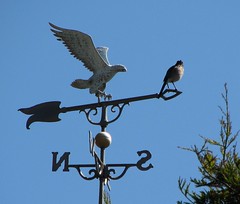
Guide to Weathervanes
In home design, it's not uncommon for functional objects to be reinvented into something decorative or ornamental. One example is the weathervane, a device originally meant to tell the direction of the wind. Once considered a practical tool for anyone working out of doors, weathervane is now as much an art form as it is a weather instrument. If you're looking to add style and value to your home, weathervanes may be just what you need.
History
The word "weathervane" comes from the Old English fane, which means banner or flag. Weathervanes have been in use ever since man learned to tell weather patterns through the wind. The earliest known use was in 48 B.C., when the Greeks placed a life-sized statue of the Greek god Triton on top of the Tower of Winds in Athens.
Around the time the New World was discovered, colonists displayed weathervanes on the highest steeples to symbolize the towns' new identity. At first, they simply used the same old figures as their European ancestors, but eventually they changed the pointer (known in the industry as the "ornament") to better reflect the town's environment. Coastal towns used figures of fish and ships; rural homes were topped with sculpted farm animals. Today, weathervanes remain one of the most popular items for outdoor home décor.
Materials
Copper is easily the most popular material for weathervanes. Its distinctive color and extreme durability make it ideal for long-term outdoor use. Copper may come with a natural or bronze finish, which are equally attractive. Natural copper turns a beautiful dark green or brown over time, while a protective finish maintains the original color. Iron and zinc coatings can also be applied.
For the more practical of us, vinyl offers great value. They are highly weather-resistant and require virtually no maintenance. Vinyl, a plastic-based synthetic material, will stand up to all sorts of weather and last years. It's not as classy as copper, but if you're after function and quality, it definitely does the job.
Wood weathervanes are mostly considered artisan crafts and are too delicate for outdoor use. You'll usually find wood weathervanes adorning shelves, tabletops or mantelpieces. As such, durability is not always a priority, so several types of wood can be used. Among the most common types are cherry, cedar and pine.
Styles
You can also choose from swell-bodied, full-bodied, and silhouette weathervanes. The swell-bodied type is by far the most common, because they have some dimension but are still thin enough to move with the wind. As the name implies, the ornament simply swells a bit in the middle. You can mount it on your rooftop or on a freestanding pole in your garden.
The full-bodied weathervane features a fully three-dimensional sculpture as its pointer. Because of the bulkier size, they are more resistant to wind and weather. However, they also need more support from the base and are harder to balance. They are recommended for rooftops in areas with strong winds and harsh weather.
Silhouette types are cut out from a flat sheet of metal. There is little to no detail, so the figures are usually those with an identifiable profile. Roosters and arrows are the most common examples. Because they don't have much structural integrity, they are best used on mount poles in gardens and gazebos.
Buying Tips
The most important thing when buying a weathervane is its size. Like cupolas, weathervanes have to be proportional in size to your house. As a general rule, ornaments measuring 8 to 15 inches are ideal for pole mounting, 12 to 20 inches will work for cottage, gazebo or small rooftop, and over 20 inches is best for full-size rooftops.
Next on your list should be balance. The unit should be designed so that the weight is equally distributed on both halves. Otherwise, the vane will tip over on the heavier side. Finally, consider your mounting options. Are you installing it on a garden pole or on top of a cupola? If it's the latter, make sure the cupola is weathervane-ready so you don't have to get roof mounts. For pole mounting, the best height is from 5 to 8 feet-high enough to be visible but not too high to allow access.
The most important thing is to make sure it reflects your own personality and style. As long as you know the basics and choose wisely, your weathervane may be one of the best additions to your home or garden.
Author : Samuel Francis
Tidak ada komentar:
Posting Komentar